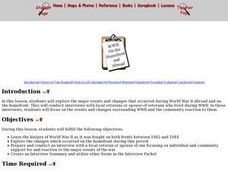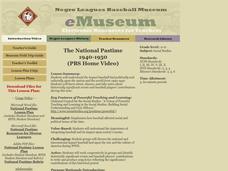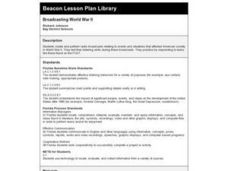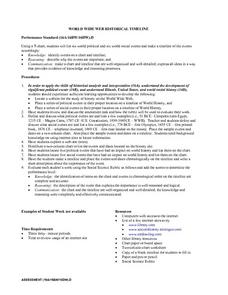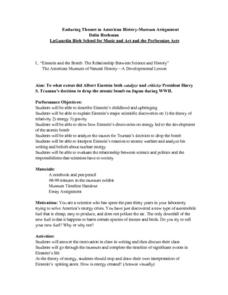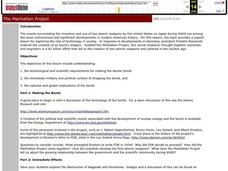US National Archives
WWII: The Pacific 1939-45 – Japan and the Atom Bomb
Though the scientists who developed the atom bomb did not believe it should be used to end World War II, American President Harry S. Truman and British Prime Minister Winston Churchill were of like mind in their decision to drop the bomb...
Curated OER
My Secret War: Lesson 5
Fifth graders determine how freedom comes with rights and responsibilities through literature and poetry about World War II. In this World War II lesson, 5th graders use the letters in the word "infamy" to write an acrostic poem. They...
Curated OER
Navajo Code Talkers of WWII
Eighth graders assess different ways that significant individuals and events influenced economic, social and political systems in the United States after 1880. They experience a Navajo code talker's dictionary to create and decode messages.
Prestwick House
The Catcher in the Rye
A 20-clue crossword puzzle tests reader's recall of events in J. D. Salinger's The Catcher in the Rye.
Curated OER
WWII Website
Tenth graders research a topic related to World War II. They explore the causes and legacy of WWII, the European Theater of Operations, the Pacific Theater of Operations, Diversity in WWII, Women in WWII, and the Homefront. Students...
Curated OER
WWII: On The Homefront and Abroad
Students explore World War II from the perspective of both the sides. They research the changes that occurred on the homefront during 1942-1944. Students prepare and conduct an interview with a local veteran or spouse of a veteran...
Curated OER
The National Pastime
Pupils examine the impact baseball had politically and culturally upon the nation and the world from 1940-1950. Students study about, discuss, and take notes about historically significant events and baseball players' contributions...
Curated OER
East Timor: The World's Newest Country
This isn't just a hand-out or a reading passage; it's more like a mini book on the history, colonization, independence, and culture of the South East Asian country of Timor. There are extensive readings and discussion questions for...
Curated OER
The Road to World War II
Middle schoolers research the orgins and early events of World War II using online and off line resources. They conduct an interview with a local World War II veteral and present their findings to the class.
Curated OER
Voyage of the St. Louis
Ninth graders explore the lives of Jewish refugees during WWII. After reading a brief passage about the people and the voyage of the St. Louis, 9th graders discuss how refugees have been treated historically. Reading and testing...
Curated OER
All Quiet on the Western Front
Students use unitedstreaming and Google Earth to investigate World War II and All Quiet on the Western Front. In this novel and technology lesson, students view a video about the novel using unitedstreaming video, visit the given...
Curated OER
Broadcasting World War II
Third graders listen to several broadcasts from the WWII era. They research, write and perform simulated radio broadcasts concerning topics related to American society in World War II.
Curated OER
A New Twist on Race Relations
Learners analyze the impact of American Bandstand on race relations. In this race relations instructional activity, students use the music and dance show American Bandstand to learn about race relations. Learners categorize pivotal...
Curated OER
Staligrad Lesson
Identify who participated in the Battle of Stalingrad and discuss its significance to the outcome of World War II. Participate in an entry task, PowerPoint presentation, and other activities presented. Finally, write a one-page paper...
Curated OER
World Wide Web Historical Timeline
Students use newspapers and magazines to identify six recent political and social events from around the world. In groups, they use a timeline template to place the events on the timeline in chronological order. They share with the...
Curated OER
Altoona Horseshoe Curve: A Vital Link
Learners explain the significance of the Horseshoe Curve. For this railroad lesson students reconstruct elements of a German plot to destroy the Horseshoe Curve.
Curated OER
Enduring Themes in American History-Museum Assignment
Students study and research the life of Albert Einstein. They focus on the extent Albert Einstein catalyzed and criticized President Harry S. Truman's decision to drop the atomic bomb on Japan during WWII. Students answer a series of...
Curated OER
Oral History Memoirs of American Experiences in Japan
Students identify the process of producing an oral history/documentary. Students analyze and synthesize information and memoirs as a valuable tool for exploring the past using primary resources. Students differentiate facts of historical...
Curated OER
The African-American Struggle for Equality in the World War II Era
Young scholars respect and appreciate the challenges people faced during World War II. They develop the different perspectives on race during WWII. Students develop that the nation's actions may not exemplify a nation's stated ideals....
Curated OER
My Secret War: Lesson 4
Fifth graders write a speech. In this history instructional activity, 5th graders define the word infamy and listen to a speech by FDR. Students work in groups to summarize his speech and rewrite sections of the speech.
Curated OER
The Manhattan Project
Students discover the technological and scientific requirements for making the atomic bomb, the immediate effects of an atomic bomb, and the social and political changes that have resulted from the Manhattan Project.
Curated OER
War Stories
Pupils watch the film "The Perilous Fight: America's World War II in Color". Using the film, they work together to develop proper interview questions to use while talking to World War II veterns. After the interview, they research the...
Curated OER
Lead Up to World War II
Twelfth graders examine Hitler's rise to power leading up to World War II. and how the Treaty of Versailles contributed to Hitler's rise to power in Germany. They identify the important countries involved in the beginning of World War II.
Curated OER
What is to Become of the World After the War?
Young scholars analyze primary sources regarding World War II. For this World War II lesson, students read "The Atlantic Charter," and respond to questions about the document.





